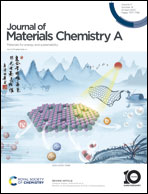On the direct correlation between the copper current collector surface area and ‘dead Li’ formation in zero-excess Li metal batteries†
Abstract
In ‘zero-excess’ (often called ‘anode-free’) lithium metal batteries (ZE-LMBs), three-dimensional (3D) current collectors (CC) with a high surface area have been reported to effectively reduce the local current density and minimize the electronically and/or ionically isolated Li metal, so-called ‘dead Li’. In most of the published works on 3D CCs for ZE-LMBs, the discussion has oftentimes primarily emphasized the relationship between the functionality of the 3D surface structure and its effect on enhanced electrochemical performance. Therefore, it is important to take a deeper look at this relationship by controlling the surface features and surface chemistry of CCs. In this work, the direct correlation between the surface area of CCs and ‘dead Li’ is thoroughly evaluated. The Li deposition behavior at the entire CC is also elucidated. A fair comparison is maintained by precisely controlling surface features and surface chemistry of the 3D copper CC which is realized by femtosecond-laser-ablation. ‘Dead Li’ is accurately quantified by gas chromatography coupled with a barrier discharge ionization detector. This study shall shed light on a deeper understanding of the correlation between surface area and ‘dead Li’ to pave the way for the application of ZE-LMBs.



 Please wait while we load your content...
Please wait while we load your content...